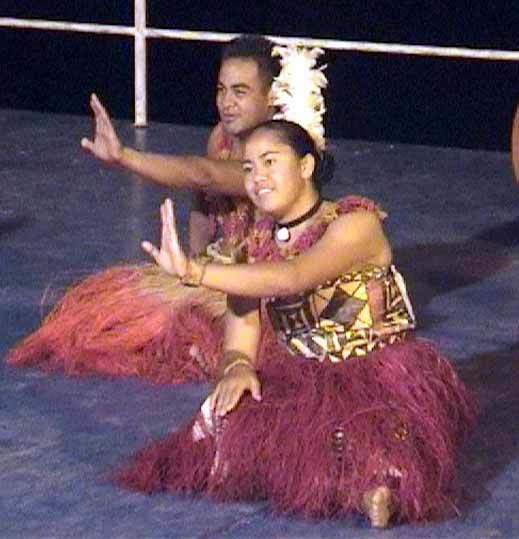 | ||
The ʻotuhaka (ʻotu-haka: row-of-dancemovements) is a traditional Tongan group dance with prominent Sāmoan influence wherein the performers are seated and make gestures with their arms only, with some accentuation from head and body.
Originally the ʻotuhaka was performed by older, chiefly ladies only, who were supposed to be too old to stand. Very often a ʻotuhaka was followed by an ula performed by their (standing) daughters or any young, chiefly ladies. In another respect, the 'Otuhaka was believed to be performed early in the morning to wake the King in a peaceful and subtle way. The performers sat crosslegged on the ground in a half circle with the guest of honour (the chief to whom they wanted to give homage) at the centre. Like the māʻuluʻulu part of the performance is on the beat of the music only, part of it is with additional singing of a chorus. The music by tradition, consists of beating with sticks on the tafua, bamboos, which are rolled up in a mat, just to keep the beat.
Nowadays the ʻotuhaka can be performed by men and women of any rank, but as dance it is decidedly less popular than its successor the māʻuluʻulu, as the words and the dance movements are prescribed by tradition. Yet every dance master who is conducting this dance has a different version which he will claim is the right one from ancient times. The people from Lapaha may have the strongest claim, as they are the guardians of the Tuʻi Tonga traditions.
Lyrics
The words of the several verses are largely archaic and since they are derived from Samoan origin some are not well understood by their Tongan performers. Several older parts seem to have to do with seafaring. A few example verses.
A quite recent example, in modern Tongan:
A verse in old Sāmoan, expressing grief about the death of the spiritual king of Tonga:
A verse in old Sāmoan. For Tongans ʻAnilai and Siulafata may be names of unknown persons, but in Sāluafata harbour on ʻUpolu was an important stopover in ancient times:
A verse in modern Sāmoan, a quite recent addition as it talks about the annexation of Tutuila by the Americans (sailors= US Navy) in 1900:
